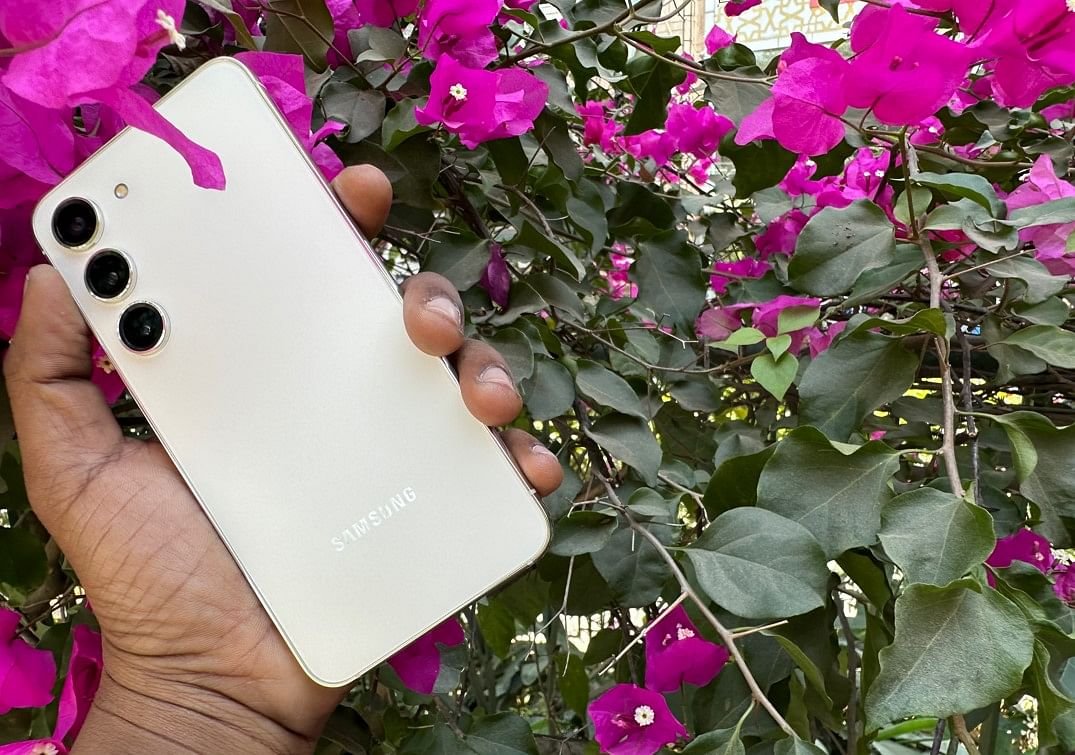
Samsung earlier in the month unveiled the company's first line of premium phones of 2023-- Galaxy S23 series.
It comes in three variants-- Galaxy S23, Galaxy S23 Plus and Galaxy S23 Ultra-- with prices ranging from Rs 74,999 to Rs 1,54,999-- in India.
I have already reviewed the big Galaxy S23 Ultra. Just last week, I started using the Galaxy S23 and here are my thoughts on Samsung's mini premium phone.
Design, build quality and display
In the early 2010s, I wouldn't have used the tag 'mini' for a 6.1-inch phone. Back then, any phone with a display of 5.0-inch and above was considered too big. But, they used to feature thick bezels and now, with advancements in flexible OLED screen technology, the companies now can stretch them to the edges and yet keep the phone's form factor compact. Now, the display panel even cascade up to the frame, which is the case with Galaxy S23 Ultra.
Here, the Galaxy S23 features a 6.1-inch display panel with slim bezels, and I, with the puny hand can even wrap around it and operate it single-handedly with ease.
The speaker at the base is very good and delivers stable audio output. It also features a Type-C port along with SIM (single nano type and eSIM support) and two mics. At the top, it has a lone mic and on the left side, it has no physical buttons as such. On the right side, you will find the volume rocker and power button.
The sides are encased by armour aluminium and the back panel and the front display are covered by a sturdy Gorilla Glass Victus 2 series shield, which can protect the device from getting scratch marks when kept in the pocket or backpack with pens and coins. Also, the device comes with an IP68 rating and can sustain water splashes or even survive drop in a swimming pool for close to five feet (1.5 metres) for close to 30 minutes. But, ensure the device is fully cleaned with a dry cloth before plugging it into the charging port.
The matte finish on the back, particularly the cream Galaxy S23 model, does an excellent job of hiding fingerprint smudges. The silver chromium-hued frame around the edge and three rear circular camera sensors beautifully blend with the ivory-coloured back panel. In the sunlight, the device looks fantastic.
The company also offer the device in three other colours-- and in four colours—phantom black, green and lavender. They are visually appealing too.
Like the Galaxy S23 Ultra, the regular S23 model is made with an environment-friendly process. The company has used waste plastics such as discarded fish nets, and pet bottles to repurpose them, to make some key components of the phone. Even the armoured aluminium around the rail is said to be recycled too.
On the front, it sports a 6.1-inch full HD+ Dynamic AMOLED 2X Display and support peak brightness up to 1,750 nits, 120Hz refresh rate (48Hz-120Hz) and with game mode-on, it can support upto 240Hz touch sampling rate.
It also boasts an improved adaptive vision booster and works flawlessly. It is noticeable how the display changes brightness according to the surrounding environment from sunny outdoors to controlled light conditions indoors, very importantly, the viewing experience for me remained the same. It is always delightful to watch vlogs on the Galaxy S series device.
And, the optical in-display fingerprint sensor does its job fine. It swiftly recognises the finger impressions and unlocks the screen without fuss. But, have to ensure, the fingers are clean and dry for the biometric security system to work smoothly.
Performance
Samsung for the first time ever collaborated with Qualcomm to build custom silicon exclusively for the Galaxy S23 series. All three models come with the 'Snapdragon 8 Gen 2 for Galaxy' chipset. It is faster and more efficient compared to the regular SD 8 Gen 2 we see in other premium Android phones.
Like the bigger sibling S23 Ultra, the smaller Galaxy S23 is really fast and smooth while performing all day-to-day chores. With RAM Plus feature, users can expand the physical memory up to 8GB extra, provided there is enough memory. This plays a critical role in making the phone respond faster in terms of app loading and switching between multiple apps.
Also, it runs Android 13-based OneUI 5.1 OS and offers a clean user interface. But, it comes with a big buffet of apps from Microsoft, Google and Samsung, eating up storage.
On the bright side, Galaxy S23's base model comes with 128GB. I believe this new standard set by Samsung, should be emulated by other brands too.
Samsung is offering the Galaxy S23 in two configurations-- 8GB RAM + 128GB storage and 8GB RAM + 256GB storage.
Compared to the predecessor, the heat dissipation is well optimised on the Galaxy S23 series thanks to the bigger vapour cooling system. During testing, it remained cool for around 15-20 minutes while operating the camera, but began to warm up. The same thing played out when I streamed videos and played Asphalt 9: Legends. I have to note that I really had to push the Galaxy S23 Ultra to the extreme, for around 40-45 minutes to turn the device warm.
However, the heating never went beyond my comfort level and was limited to space beside the triple-camera system. If the device is covered with a shell case, one might not feel the phone warming up.
As far as battery life is concerned, it is very subjective to individual behaviour. Normal day-to-day usage activities like scrolling on social media platforms, reading news on the internet, answering/making calls, messaging and emails, can easily give you a full day.
But, if you are an extreme user, like to play a lot of games longer or binge on multimedia content on OTT apps or watch reels on Instagram for several hours a day, the Galaxy S23 with Wi-Fi connection can last for five or six hours depending on the quality of the video. But, on cellular data, the draining is faster.
On Wi-Fi, the Galaxy S23's battery dropped by around three per cent while watching HD vlogs for 20 minutes.
I always suggest, if you want the phone last longer, download episodes of the TV series or the movies the previous night via Wi-Fi, and watch them offline the next day. This way, it will greatly reduce battery consumption.
Read more | Android: Tips on how to ensure device's battery life lasts a full day
Samsung's new Galaxy S23 supports 5G cellular service offered by both Airtel and Reliance Jio in India.
Photography
It boasts a triple-camera module-- 12MP ultra-wide camera (f2.2, 120-degree field-of-view, 13mm, 1/2.55-inch 1.4µm pixel size) backed by a 50MP wide camera (f/1.8, FOV: 85-degree, 1/1.56-inch, 1.0µm, Dual Pixel PDAF, OIS) and 10MP telephoto lens (3x Optical Zoom, F2.4, FOV 36-degree) with LED flash.
As evident in the sample photos, Samsung has done a great job with the Galaxy S23's camera hardware. It takes fantastic photos in all light conditions.
Though the native camera apps go overboard with colours, particularly on flowers, delivering punchy and vibrant photos. The most important thing is, the details are captured well.
The portrait mode works like charm, the phone does a good job with clear differentiation of the foreground and background of the subject. The edge detection around the contours of the subject are well defined to an extent in some of the samples I have captured on the Galaxy S23.
With the night mode on, the phone again comes on top in capturing all details, not just the subject, but also the surrounding, despite the dearth of light.
Compared to S23 Ultra, which supports 100X Space Zoom, the Galaxy S23 supports up to 30X Zoom. The pictures are good and I can make out the type of birds on a tree.
The 3X optical zoom works like a charm with hardly any loss of quality. Check out the sample photo below.
The close-up shots too, come off really well with even minute details captured in great detail.
Like the S23 Ultra, the regular S23 too supports Astrophoto and Hyperlapse modes. But, couldn't get any spectacular images of galaxies or stars on light-polluted city skies like in Bengaluru. They are best used on city outskirts with fewer street lights in the vicinity.
With Object Eraser, Photo Remaster, Astrophoto, Hyperlapse and other value-added photography tools, the Galaxy S23 offers an edge over other premium phones. Of course, barring Google's Tensor-powered Pixel 7, 7 Pro series, which has set very high standards for still photos.
As far as video recording is concerned, the Galaxy S23 comes with gyro-EIS (Electronics Image Stabiliser), captured pretty good stable videos. There is a definite improvement over the predecessor. It can record up to 8K with a 24/30 fps (frames per second) option. The videos are really fantastic and capture the minute details and colours of objects in the scene very well. It is a good option to record videos for personal blogs on social media blogs. It can also record 4K (at 30/60 fps) and also slow motion video--full HD (1080p) at 960fps. They are good too.
On the front, the Galaxy S23 comes with 12MP (f/2.2, FOV: 80-degree) sensor. It takes excellent selfies and even the portraits are just top-class, worthy to be used as DP on social media platforms. Even the videos too, are great, on par with other premium phones in the market. It can take 4K at 30/60 fps and full HD 1080p at 60 fps.
Final thoughts
Samsung Galaxy S23 may look puny in front of its 6.8-inch sibling S23 Ultra, but it is no less of a formidable premium phone than the latter. It excels in delivering fast and smooth performance and even the photography hardware too, is noteworthy. The display panel is one of the best I have seen on a smartphone; really good for multimedia consumption, be it watching videos or scrolling through social media platforms, reading news or playing games. The Adaptive Vision Booster truly lives up to the hype and ensures a pleasant viewing experience in all light conditions.
However, the battery life, particularly if relied on cellular data for streaming multimedia for long sessions, may drain faster. But, with Wi-Fi and careful planning (as mentioned in the tutorial article link placed in the performance section), the Galaxy S23 can be able to last a full day under normal usage.
The Galaxy S23 will find takers among niche premium phone users who want the best of everything but in a compact form factor. As of now, there is none in the Android ecosystem that can come close to Samsung's device in terms of the 'mini flagship phone' class.
The new Galaxy S23 is available in two options—8GB RAM + 128GB storage and 8GB RAM + 256GB storage—for Rs 74,999 and Rs 79,999, respectively.
Must read | Samsung Galaxy S23 Ultra review: Just impressive
Get the latest news on new launches, gadget reviews, apps, cybersecurity, and more on personal technology only on DH Tech.
